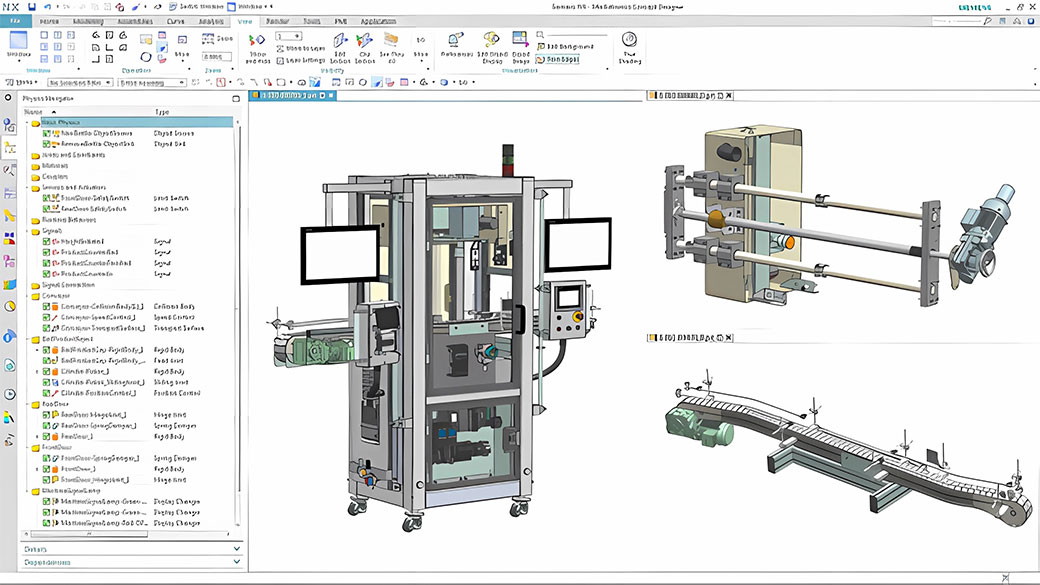Welcome to the world of mechatronic design with NX Mechatronics Concept Designer (NX MCD)! This software empowers you to create, simulate, and optimize mechatronic systems – a perfect blend of mechanical, electrical, and control engineering.expand_more This beginner-friendly tutorial will guide you through a simple project, introducing you to NX MCD’s core functionalities.
Introduction to NX MCD
Imagine a world where you can design a robot arm, simulate its movement, and program its control logic – all within a single platform. That’s the magic of NX MCD. It streamlines the entire mechatronic design process, eliminating the need for separate tools for each discipline.
Here are some key benefits of using NX MCD:
- Integrated Design Environment: Work seamlessly with mechanical components, electrical actuators, and control systems in one place.
- Simplified Simulation: Test your design virtually, identifying potential issues and optimizing performance before physical prototyping.
- Enhanced Collaboration: Facilitate communication between mechanical, electrical, and control engineers, fostering a collaborative design approach.
NX MCD vs Traditional Design Methods:
Traditional Design Methods:
- Siloed Approach: Each discipline (mechanical, electrical, control) uses separate tools and workflows, leading to communication gaps and potential inconsistencies.
- Physical Prototyping: Verifying design functionality often relies on building physical prototypes, which can be time-consuming and expensive.
- Limited Collaboration: Information exchange between disciplines can be cumbersome, hindering real-time collaboration and iteration.
- Error-Prone: Disconnects between design phases can lead to errors that might not be caught until later stages, increasing rework costs.
Advantages of NX MCD:
- Integrated Environment: NX MCD unifies mechanical, electrical, and control systems in a single platform, facilitating seamless collaboration and data exchange.
- Virtual Prototyping: Perform simulations before physical prototyping, allowing for early identification and correction of design flaws, saving time and resources.
- Enhanced Communication: Real-time visualization and data sharing foster better communication between disciplines, leading to a more cohesive design process.
- Reduced Errors: The integrated nature of NX MCD minimizes the risk of errors slipping through the cracks, leading to a more robust final design.
Benefits Breakdown:
Here’s a closer look at how NX MCD addresses the shortcomings of traditional methods:
- Reduced Development Time: Virtual prototyping eliminates the need for lengthy physical prototyping iterations, accelerating the design process.
- Improved Design Quality: Early identification of issues during simulations leads to a higher quality final product with fewer errors.
- Enhanced Collaboration: Real-time data sharing fosters a collaborative environment, where each discipline can contribute effectively.
- Reduced Costs: Virtual prototyping minimizes the need for physical prototypes, lowering overall development costs.
Getting Started with NX MCD
- Project Setup:
- Launch NX and select “New…” from the File menu.
- Choose “NX Mechatronics Concept Designer” as the template and give your project a name.
- Click “OK” to create your new project.
- Building the Mechanical Model:
- In the “Object Browser,” navigate to “Rigid Bodies” and select “Block.”exclamation
- Click and drag on the canvas to create a rectangular block representing the base of your system.
- Repeat the process to create another block for the moving arm.
- Defining Joints:
- Select the two blocks and choose “Joint” from the “Create” menu.
- Select “Revolute Joint” as the joint type, which allows for rotational movement.
- Define the joint axis by clicking on two points on the desired axis of rotation.
- Adding Actuators:
- Navigate to “Actuators” in the Object Browser and select “Linear Motor.”exclamation
- Position the motor on the base block, aligning it with the moving arm for future connection.
- Repeat the process for a “Rotary Motor” if your design requires additional rotational control.
- Implementing Sensors:
- From the “Sensors” section, choose a suitable sensor type, such as a “Position Sensor.”
- Place the sensor strategically on the moving arm to track its position.
- Building the Control System:
- Navigate to “Signals” and create a “Signal” to represent the desired movement of the arm.
- Connect the signal output to the input of the chosen motor (linear or rotary).
- Connect the sensor output (position data) to another signal for monitoring purposes.
- Simulating the System:
- Click the “Simulate” button on the toolbar.exclamation
- Define the simulation parameters like duration and speed.
- Run the simulation to observe the movement of your virtual mechatronic system.
- Analyzing Results:
- The simulation results will visualize the movement of the arm and provide data on the sensor readings.
- Analyze this data to identify any potential issues like overshoot or sluggish movement.
Congratulations! You’ve just completed your first NX MCD project. This basic exercise introduces you to the core functionalities: building mechanical models, defining joints and actuators, and establishing a simple control system.
Remember, this is just the beginning! NX MCD offers a vast array of advanced features like complex motion control, multi-body dynamics simulations, and integration with other NX modules.
Additional Tips:
- Explore the NX MCD documentation and online tutorials for further in-depth learning.
- Practice with different types of components, joints, and control systems to expand your skillset.
- Utilize NX MCD’s visualization tools to create clear and informative presentations of your designs.
With practice and exploration, NX MCD will become your go-to tool for designing, simulating, and optimizing innovative mechatronic systems. So, dive in and unleash your creativity!

